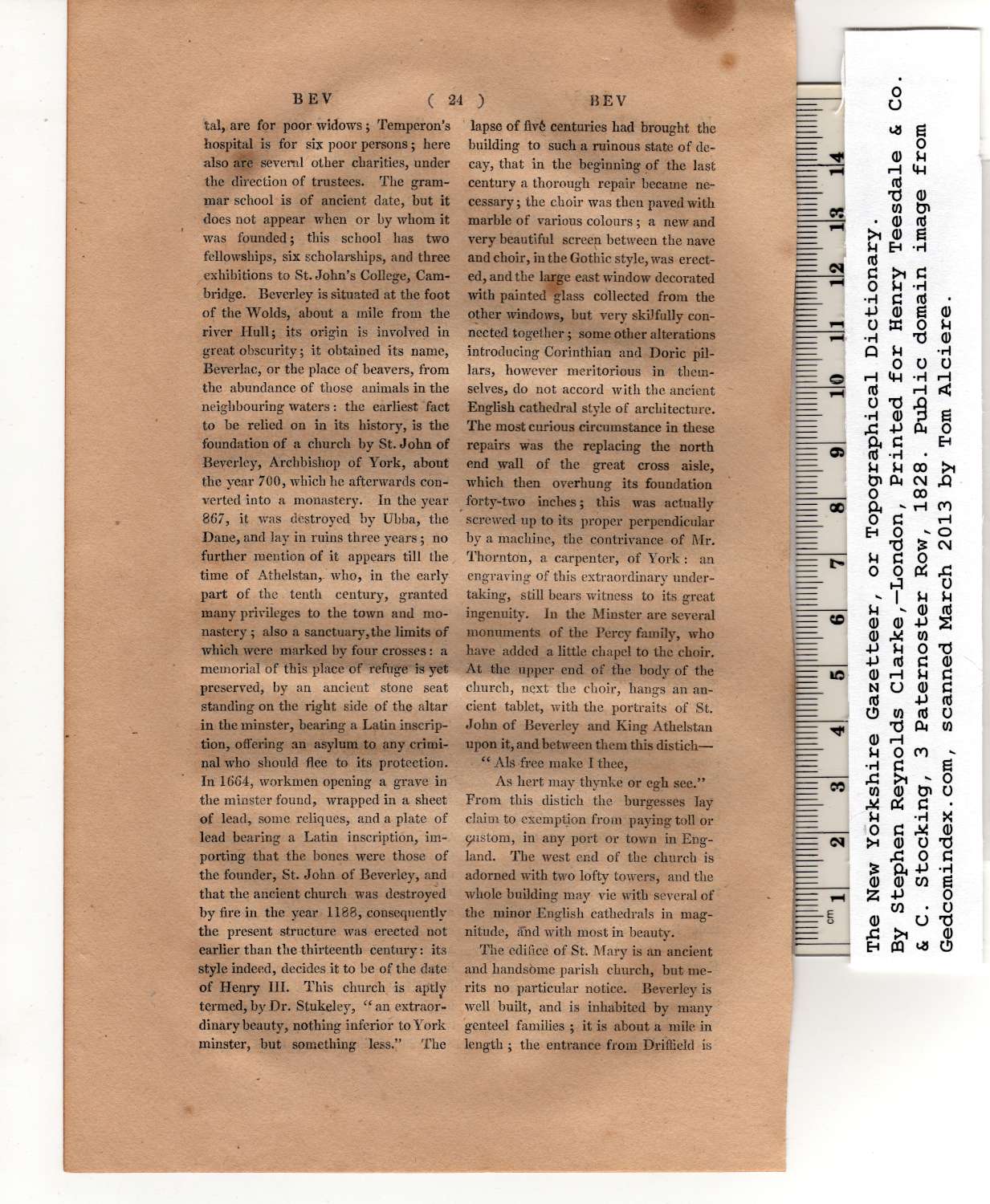|
tal, are for poor widows; Temperon’s
hospital is for six poor persons; here
also are several other charities, under
the direction of trustees. The gram-
mar school is of ancient date, but it
does not appear when or by whom it
was founded; this school has two
fellowships, six scholarships, and three
exhibitions to St. John’s College, Cam-
bridge. Beverley is situated at the foot
of the Wolds, about a mile from the
river Hull; its origin is involved in
great obscurity; it obtained its name,
Beverlac, or the place of beavers, from
the abundance of those animals in the
neighbouring waters: the earliest fact
to be relied on in its history, is the
foundation of a church by St. John of
Beverley, Archbishop of York, about
the year 700, which he afterwards con-
verted into a monastery. In the year
867, it was destroyed by Ubba, the
Dane, and lay in ruins three years; no
further mention of it appears till the
time of Athelstan,. who, in the early
part of the tenth century, granted
many privileges to the town and mo-
nastery ; also a sanctuary, the limits of
which were marked by four crosses: a
memorial of this place of refuge is yet
preserved, by an ancient stone seat
standing on the right side of the altar
in the minster, bearing a Latin inscrip-
tion, offering an asylum to any crimi-
nal who should flee to its protection.
In 1664, workmen opening a grave in
the minster found, wrapped in a sheet
of lead, some reliques, and a plate of
lead bearing a Latin inscription, im-
porting that the bones were those of
the founder, St. John of Beverley, and
that the ancient church was destroyed
by fire in the year 1188, consequently
the present structure was ereeted not
earlier than the thirteenth century: its
style indeed, decides it to be of the date
of Henry III. This church is aptly
termed, by Dr. Stukeley, “ an extraor-
dinary beauty, nothing inferior to York
minster, but something less.” The
lapse of fiv6 centuries had brought the
building to such a ruinous state of de-
cay, that in the beginning of the last
century a thorough repair became ne-
cessary ; the choir was then paved with
marble of various colours; a new and
very beautiful screen between the nave
and choir, in the Gothic style, was erect-
ed, and the large east window decorated
with painted glass collected from the
other windows, but very skilfully con-
nected together; some other alterations
introducing Corinthian and Doric pil-
lars, however meritorious in them-
selves, do not accord with the ancient
English cathedral style of architecture.
The most curious circumstance in these
repairs was the replacing the north
end wall of the great cross aisle,
which then overhung its foundation
forty-two inches; this was actually
screwed up to its proper perpendicular
by a machine, the contrivance of Mr.
Thornton, a carpenter, of York: an
engraving of this extraordinary under-
taking, still bears witness to its great
ingenuity. In the Minster are several
monuments of the Percy family, who
have added a little chapel to the choir.
At the upper end of the body of the
church, next the choir, hangs an an-
cient tablet, with the portraits of St.
John of Beverley and King Athelstan
upon it, and between them this distich— |
“ Als free make I thee,
As hert may thynke or egh see.”
From this distich the burgesses lay
claim to exemption from paying toll or
9«stom, in any port or town in Eng-
land. The west end of the church is
adorned with two lofty towers, and the
whole building may vie with several of
the minor English cathedrals in mag-
nitude, and with most in beauty.
The edifice of St. Mary is an ancient
and handsome parish church, but me-
rits no particular notice. Beverley is
well built, and is inhabited by many
genteel families ; it is about a mile in
length ; the entrance from Driffield is |
